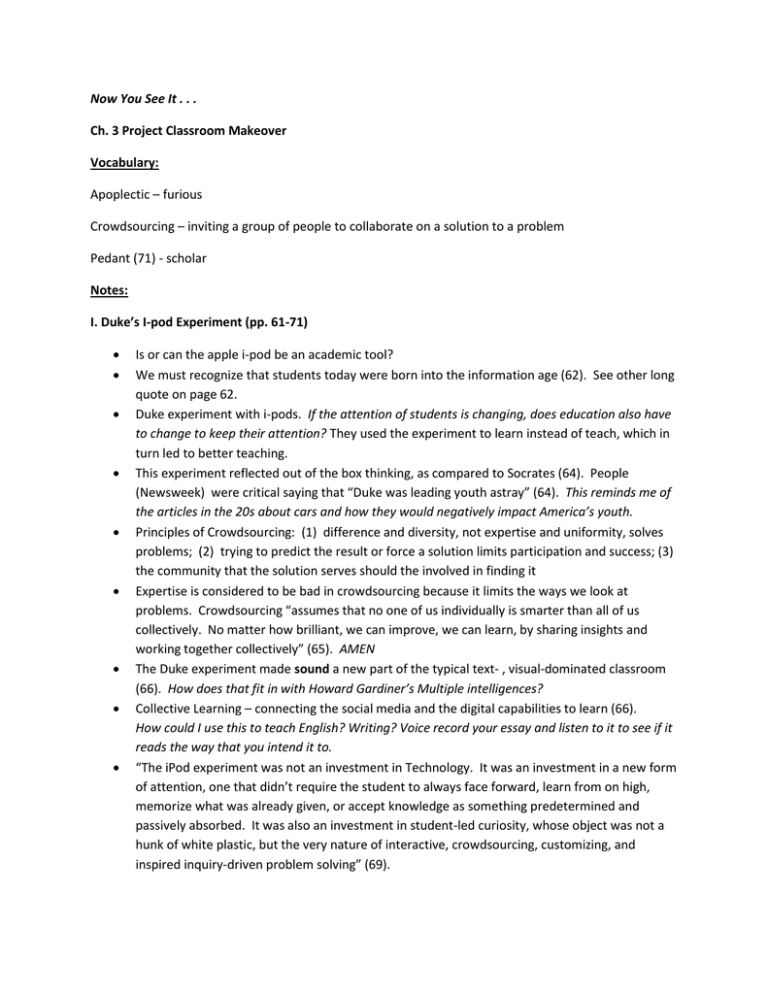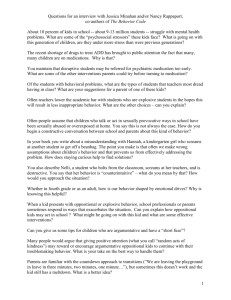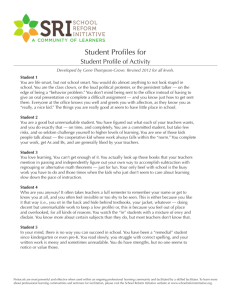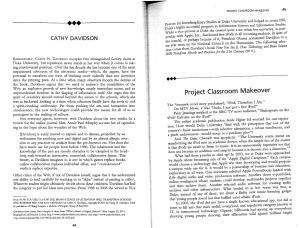Now You See It . . . Vocabulary: Apoplectic – furious
advertisement

Now You See It . . . Ch. 3 Project Classroom Makeover Vocabulary: Apoplectic – furious Crowdsourcing – inviting a group of people to collaborate on a solution to a problem Pedant (71) - scholar Notes: I. Duke’s I-pod Experiment (pp. 61-71) Is or can the apple i-pod be an academic tool? We must recognize that students today were born into the information age (62). See other long quote on page 62. Duke experiment with i-pods. If the attention of students is changing, does education also have to change to keep their attention? They used the experiment to learn instead of teach, which in turn led to better teaching. This experiment reflected out of the box thinking, as compared to Socrates (64). People (Newsweek) were critical saying that “Duke was leading youth astray” (64). This reminds me of the articles in the 20s about cars and how they would negatively impact America’s youth. Principles of Crowdsourcing: (1) difference and diversity, not expertise and uniformity, solves problems; (2) trying to predict the result or force a solution limits participation and success; (3) the community that the solution serves should the involved in finding it Expertise is considered to be bad in crowdsourcing because it limits the ways we look at problems. Crowdsourcing “assumes that no one of us individually is smarter than all of us collectively. No matter how brilliant, we can improve, we can learn, by sharing insights and working together collectively” (65). AMEN The Duke experiment made sound a new part of the typical text- , visual-dominated classroom (66). How does that fit in with Howard Gardiner’s Multiple intelligences? Collective Learning – connecting the social media and the digital capabilities to learn (66). How could I use this to teach English? Writing? Voice record your essay and listen to it to see if it reads the way that you intend it to. “The iPod experiment was not an investment in Technology. It was an investment in a new form of attention, one that didn’t require the student to always face forward, learn from on high, memorize what was already given, or accept knowledge as something predetermined and passively absorbed. It was also an investment in student-led curiosity, whose object was not a hunk of white plastic, but the very nature of interactive, crowdsourcing, customizing, and inspired inquiry-driven problem solving” (69). This new way of learning is not better or worse, it is just different. “We concentrate in a different way when we are making the connections, when we are clicking an browsing, than when we are watching (as in a TV show or movie) or listening or even reading a book” (70). We can now learn using all of these ways. It just gives us more options. SUMMARY: The question is “How do we make over the twentieth-century classroom to take advantage of all the remarkable digital benefits of the twenty-first century?” (71). TRANSITIONAL ELEMENT II. American Education – Then to Now (pp. 71-81) “It’s shocking to think of how much the world has changed since the horse-and-buggy days of Sleepy Hollow and how little has changed within the traditional classroom of America” (71). New technological advances have impacted us in the past, and we have adapted. i.e. around the late 1700’s (the time of our Constitution) the printing press revolutionized our thinking as mass printing allowed books, newspapers, etc., to put printed materials in the hands of middleclass readers for the first time in human history. A new institution called a library allowed even the poor access to books and reading materials (72). The author moves into the history of American education, showing how and why we do things the way we do. i.e. summer break to accommodate the agricultural year and farming, a process that mimics the labor required on the assembly line, etc. – 1800’s focused on elementary education (the first educational reform) (72). Other school norms tuned to the changes in society – specialization, focused attention, sticking to a schedule Shift in 1900’s to secondary education and leadership skills because of America’s shift in world power. The importance of school during this time also shifted as the percentage of student s graduating from high school jumped from 15-50% (74). “Robert Schwartz, dean of the Harvard Graduate School of Education, motes that since the last quarter of the twentieth century, the pattern of educational expansion that has characterized the United States from the Revolutionary War forward has changed. Since 1975, American educational attainment has leveled off or even dropped while there is a dramatic increase in the number of jobs requiring exploratory, creative problem solving typically encouraged by postsecondary education. We are see the first signs that our education system is slipping in comparison to our needs” (74). Our high school and college graduation rates have remained pretty static since 1975, while everything else has changed dramatically. We are also falling behind in the global education race (75). 1995-2005 – America dropped from 2nd to 15th place in college completion rates (75). “Kids aren’t failing because school is too hard but because it doesn’t interest them. It doesn’t capture their attention” (76). Is this true? Ask the class. “Relevance has been proved to be a crucial factor for keeping students in high school, especially mid- and lower-level students” (76). The new three R’s of Education – Rigor, Relevance, Relationships (76). DISCUSS, DISCUSS, DISCUSS!!! Brain research shows “that kids improve with directed, special attention to their own skills and interests, the opposite of our move toward standardization” (76). We must shift to preparing students for creative thinking at all levels. This kind of thinking cannot be done by a computer. Problem-solving abilities. Interpersonal Skills. “The more standardized our assessment, the more kids fail. Their failure is then diagnosed as a learning disability or a disorder. But they are failing when assessed by a standard that has almost nothing to do with how they learn online or – more important – what skills they need in a digital age” (77). Inquiry-based opportunities are the key. FOR ME: “The world is full of problems to solve that cost little except imagination, relevant learning, and careful guidance by a teacher with the wisdom to not control every outcome or to think that the best way to measure is ky keeping each kid on the same page or the same book at the same time” (78). Disability Labeling – ADD goes away when a kid is interested. We are missing kids!!!! Is this true? BELLWORK PROMPT: WHAT HAS BEEN THE MOST FORMATIVE(INFLUENTIAL OR SHAPING) EXPERIENCE OF YOUR LIFE IN SCHOOL? DISCUSSION – IS THERE SOMETHING EXPERIMENTAL OR DARING OR SOMETHING MORE IN THESE EXPERIENCES? SUMMARY: Part II of this chapter gives the background of education. Her purpose here is to show how education has and should change as our society does. She challenges us to consider what changes the current developments in technology may pose for our education system. III. The Other Mrs. Davidson(pp. 82-86) Davidson uses the anecdotal story of her former mother-in-law in Canada as a model for what teaching should really be. This woman taught using games and interactive communal learning activities – but she was tough (83). She did not believe in learning disabilities She believed that “everyone had a unique way of learning and believed that to be true of the smartest students as well as the academically weakest” (83). She used a game in which she had contests every Friday over the material learned that week. The previous week’s winners would devise the competition – from the questions to the rules, etc. They would explain these to the other group. One group would test the other group. She was the referee. The winner would get 15 minutes of free time, while the losers would begin early study of the next week’s material. How could I do something like this that would inspire kids like this did in my classroom? We need interactive, motivated, inspired, and curious form of learning. How do I do this with ENG in my classes? How do I make my curriculum become problems and intellectual obstacle courses which require kids to work together toward a solution? “Confidence in your ability to learn is confidence in your ability to unlearn, to switch assumptions or methods or partnerships in order to do better” (86). SUMMARY: In order to continue reaching children and teaching them – truly teaching them – we must make our teaching interactive, problem-solving, and challenging and we may have to learn how to unlearn some of the things we have taken to heart in order to improve. IV. Gaming School (pp. 87-90) Critical Response: Question: pg. 62 states that we should start asking students what they should know. My question is, if they don’t know about something, how can they ask us to teach them about it? We still have to expose them to things that they haven’t been exposed to. What kid is going to ask you to teach grammar? Use of ethos – “I was a vice provost for interdisciplinary studies at Duke” (63).



